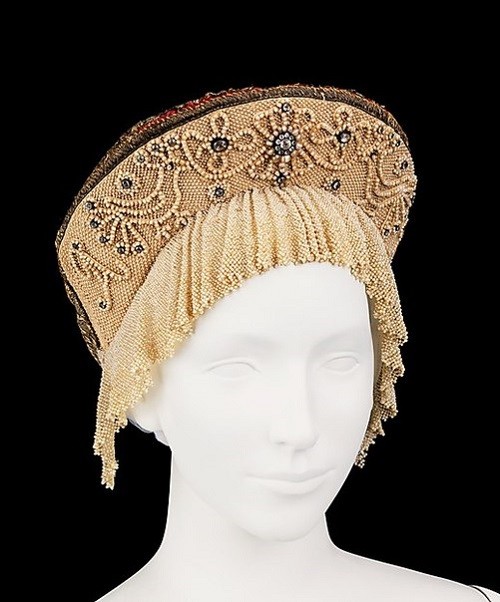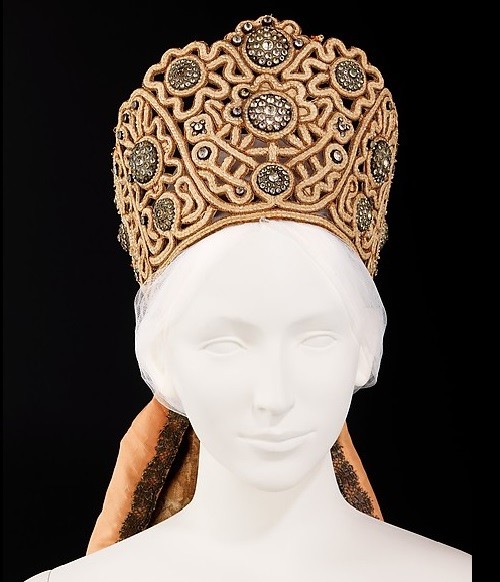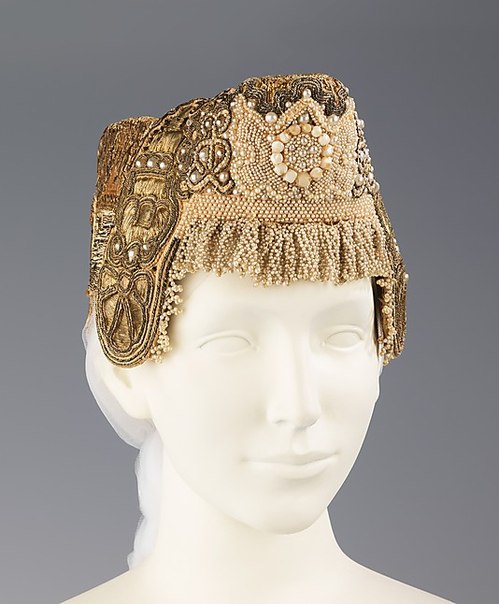
Brooklyn Museum Costume Collection at The Metropolitan Museum of Art exhibits Samples of Russian applied art, and a significant part of it Traditional Russian Headdresses. Things out “Assembly of Russian antiquity” Russian noblewoman Natalia Leonidovna Shabelsky (1841-1905) devoted her life to the conservation of endangered folk art traditions. The exhibition features collections from the Boston Museum of Fine Arts, the Cleveland Museum of Art, and the Russian Museum of Ethnography in St. Petersburg.

Natalia Leonidovna Kroneberg (Natalia de Shabelsky) was born in 1841 in Taganrog in the family of Leonid Alexandrovich Kroneberg. She graduated from Kharkov Women’s Institute. In 1862 she married Peter Nikolaevich Shabelsky, a major landowner in Kharkov province. In this marriage were born three daughters – Varvara Petrovna Shabelsky (by marriage Sidamon – Eristavova), Natalya Petrovna Shabelsky, and the name of the third daughter is unknown. Until the end of 1870 the family lived in the estate “Chupahovka” Kharkov province (now Akhtyrsky district of Sumy region) owned by Pyotr Nikolayevich, where Natalia had her first embroidery workshop. In the early 1880s the family moved to Moscow.

Traveling throughout Russia, Natalia began collecting fine antiques – Russian folk embroidery, lace, fabric, hats, garments, bone carving, metal and wood samples of craft. Her Moscow house turned into a museum of Russian antiquity. Catalog of the collection included more than 4,000 items. This collection was the largest collection of Russian textile of the second half of XIX – early XX centuries.
In 1893, Natalia showed her collection at the World’s Fair in Chicago in 1894 in Brussels and Antwerp, and in 1900 at the World Exhibition in Paris, where she was awarded a bronze medal. In 1902 the family of Shabelsky moved for permanent residence to France.

January 17, 1904 Natalia Shabelsky died. She was buried at St. Nicholas Russian Orthodox cemetery “Kokad” in Nice. V.V. Stasov wrote in his obituary: “After several years of training she became one of the greatest scholars and major characteristic of this branch of the ancient Russian art, and her house in Moscow became a real museum, extraordinarily rich and varied”. After the death of Natalia part of her collection was sold by her daughter. Remains found in private collections and museums.

Shabelsky amassed a large collection of intricately embroidered hand-woven household textiles and opulent festival garments with rich decoration and elaborate motifs.



Married women were required to cover their hair entirely lest they be considered immodest, therefore headdresses, or kokoshniks were often accompanied by a venchik, a forehead covering made of fabric or metal, as seen here with headdress. Peter the Great’s (1672-1725) attempts to Westernize Russia were partially manifested in changes to the traditional costume of the court. Though they were not required by law to adhere to the reformations, the peasant class commonly adopted aspects of Western styles blended with folk dress. This headdress in particular is an excellent example of the melding of cultures found in Russian history.

Headdresses, or kokoshniks had the greatest abundance of ornamentation of any type of garment in Russia. They were most often made of damask woven with gilt metallic threads or velvet with gold embroidery. This is a particularly handsome piece with elaborate needlework and incorporating a significant amount of gold, signifying its owner was from a wealthy family.


This headdress follows the coronet shape common to maiden’s headwear in Russia while incorporating the forehead veil effect of the venchik. Unlike in most headdresses where the venchik is a separate piece, the characteristic beaded veil is attached directly to the headdress

Headdresses from the North were embellished with the river pearls that were plentiful in that area while goose down and woolen embroideries were more popular in the South. Olonetz is located on the Olonka River, and the province of Novgorod contains several rivers, as evidenced by the abundant use of pearl decoration. This type of headdress can also be seen in portraits of Russian royalty dating from the Middle Ages through the 19th century.

This headdress, from Tver is heavily adorned with mother-of-pearl beads. The city of Tver is located at the confluence of the Volga and Tvertsa Rivers. The decorative elements used in headdresses were representative of the regions in which they were made

This headdress is spectacular both in size and rendering. The dense decoration as well as the Russian heraldic symbol creates a sense of grandeur and importance.

Traditional Russian costume consists of straight, flowing lines. Beginning at the turn of the 18th century, the sarafan, a long, sleeveless dress, became the most popular article of peasant women’s clothing in the Northern and Central regions of Russia. The sarafan is worn with a shirt, belt, and apron. In some areas, the epanechka, a short bodice identical in shape to the sarafan supplemented the basic ensemble.


Russian headdress. Date – 19th century. Medium – silk, metal, paper. Brooklyn Museum Costume Collection at The Metropolitan Museum of ArtDiadems with open tops such as these were only worn my unmarried women in order to showcase their hair, considered a prize possession. Russian beliefs stated that evil could be worked against a married woman if her hair was exposed; therefore they were required to hide their hair under a full headdress. The geometric depiction of the goddess in this headdress is unique. The inclusion of a heart in the central motif indicates this may have been a bridal headdress. Combined with the dense gold embroidery, fine silks, and metallic lace, this creation has a sense of importance and characterizes the significance of clothing in Russian culture.


Russian women are renowned for masterful embroidery, as evidenced by this headdress back from the 19th century. The sinuous lines in the embroidery motifs add to an overall sense of vitality and elegance. The tree of life, a common motif in many design vocabularies is a symbol of fertility, as well as a connection between earth and the heavens.


This fine embroidered example incorporates several common motifs in Russian costume. The tree of life is a common motif in religious Russian manuscripts dating back to the 12th century. The country’s sovereignty was symbolized by the heraldic double-headed imperial eagle.









